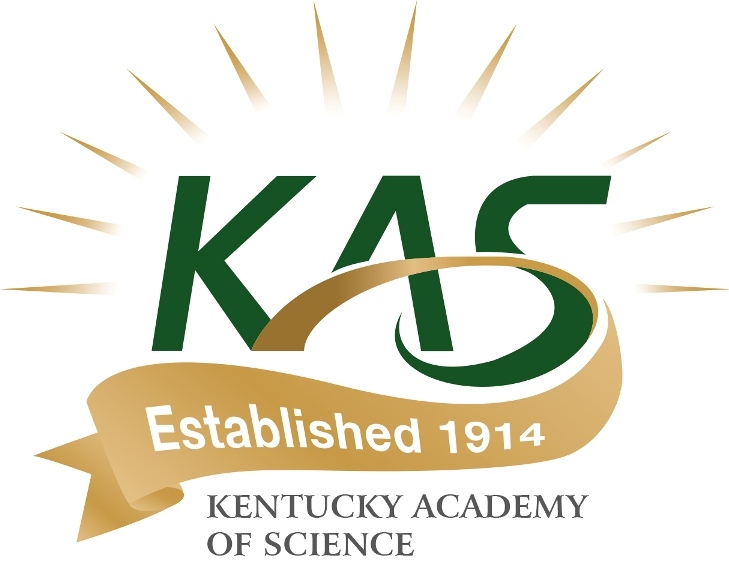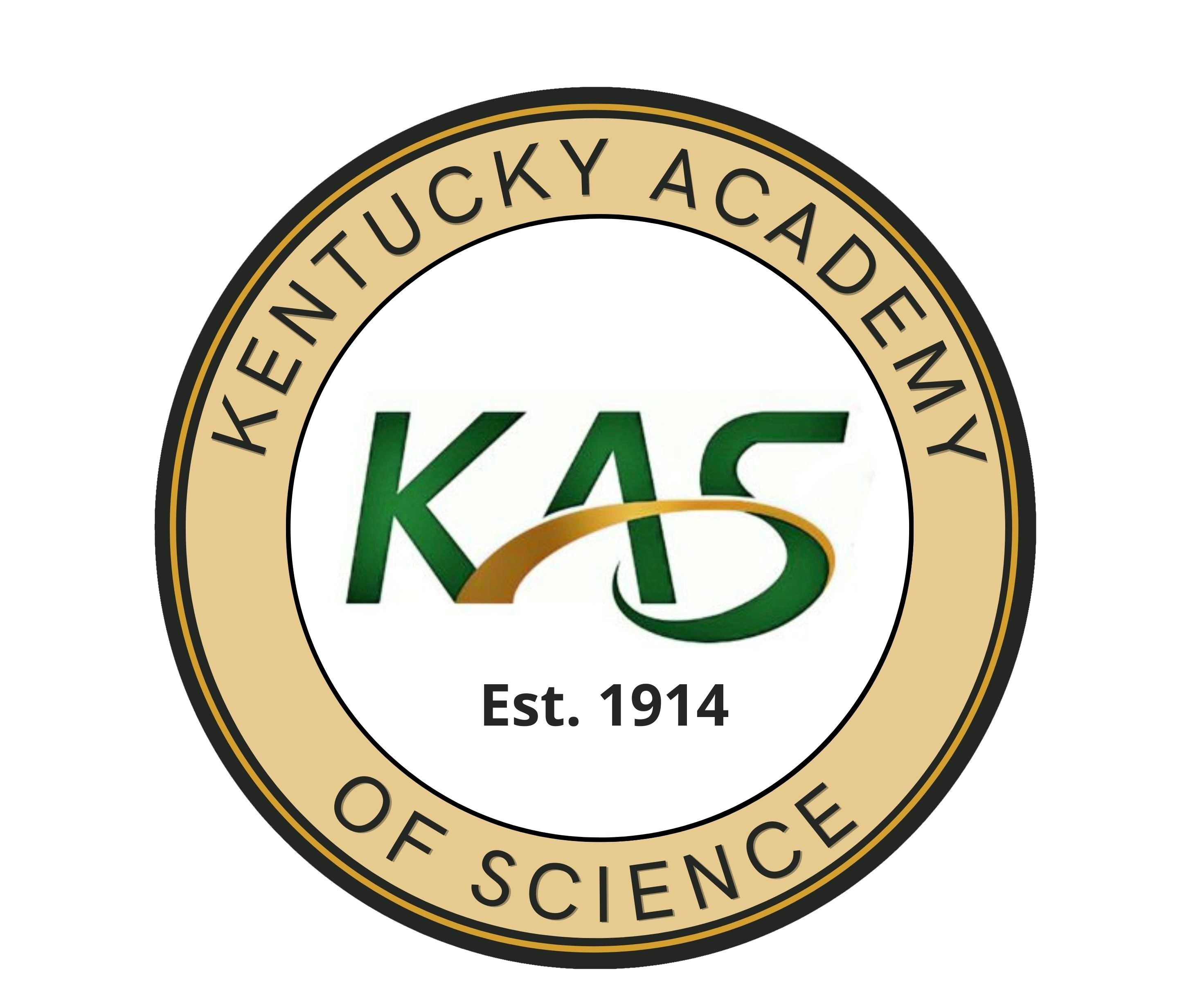Kentucky Academy of Science

2018 Annual Meeting Program
November 2-3, 2018
Western Kentucky University

Thank you to our Gold Sponsor

Thank you to our Morning Break Sponsor

Thank you to our Afternoon Break Sponsor

Thank you to our Bronze Sponsor

Thank you to our In-Kind partners


WKU Office of Research and Creative Activity
Thank you our Local Arrangements Team at WKU:
Ryanne Gregory, Leslie North, Cheryl Davis, Claire Rinehart, Kerrie McDaniel, Richard Gelderman and Rodney King.
Online Program, 2018
Poster presentations are Friday from 3-6 pm and Posters will all remain in place through Saturday.
Oral Presentations are Friday from 1:15-3 pm and Saturday 8am-4pm
This event is FULL.
Featured Speakers:
Dr. Matthew Gentry, Professor Department of Molecular and Cellular Biochemistry, University of Kentucky and Chair, Public Affairs Advisory Committee, American Society of Biochemistry and Molecular Biology

Dr. Matthew Gentry received his B.S. from the University of Evansville in 1996. He then studied yeast cell cycle regulation via protein phosphatase 2A at Syracuse University in Dr. Richard Hallberg’s lab, receiving his Ph.D. in 2003. He was a postdoctoral fellow at UC-San Diego with Dr. Jack Dixon where he discovered glycogen and starch phosphatases and how they are integral for both human and plant energy metabolism.
He began his independent career in 2008 and he is currently a Professor in the College of Medicine at the University of Kentucky where he oversees projects on both Lafora disease and biofuels research. The lab focuses on the regulation of specific phosphatases and E3 ubiquitin ligases in both human glycogen and plant starch metabolism utilizing in vitro biochemical and structural techniques; in situ cell culture models; and in vivo mouse, algal and plant models. Dr. Gentry has been continuously funded by NINDS since 2006, he is an NIH K99/R00 Pathway to Independence Award recipient, he received the NIH Young Investigator IDeA Maciag Award, the 2018 NINDS Landis Award, he is an NSF CAREER awardee, and PI of both a NINDS R01 and P01. He is a Journal of Biological Chemistry Editorial Board member, Director of the NIH-funded Lafora Epilepsy Cure Initiative, and Chair of the ASBMB Public Action Advisory Committee (PAAC).
 e, Kentucky Academy of Science
e, Kentucky Academy of Science
With this new method, possible message space that may contain two distinct messages that collide using SHA-1 is bigger than the original message space of SHA-1.
Internet of Things (IoT) is an advanced ever-growing network of physical
objects each of which is equipped with processing and networking
capabilities and can communicate with each other. Typical IoT devices
include laptops, smartphones, and computers, smart meters, home alarm
systems as well devices such as Point of Sale (PoS) systems, cars,
refrigerators that are connected to the Internet.
In recent years many businesses (restaurants, grocery stores, and so on) have been switching from
traditional cash registers to Point of Sale (PoS) systems because of their
convenience and capabilities. As these PoS systems join the local network
of the business concerned and become accessible via the Internet, they
become increasingly exposed to various types of external attacks which can
cripple the business operations if they are not secure. Using the IoT
search engine, Shodan, we conducted an extensive analysis of the
vulnerabilities (in particular the vulnerability associated with the
Oracle PoS Systems known as CVE-2018-2636 which affected over 330,000
systems in early 2018) of PoS systems currently connected to the
Internet using a program we have developed. Our analysis revealed the
existence of 125 vulnerable PoS out of which 70 are located in the United
States but none in the State of Kentucky. Our vulnerability scanning
results of PoS systems demonstrate how vital it is to properly secure them
as they become part of the IoT ecosystem and mitigate the ever-growing
security risks they face similar to other IoT devices.
This project has been funded by the NSF grant #320001636 (PI: M. Farman).
The design is the next iteration of the PocketQube design, with a more efficient packing factor allowing for the deployment of 21 ThinSats with a standard 3U Canisterized Satellite Dispenser (CSD). The standard is based on a common bus with set electrical and mechanical interfaces that simplifies the development and integration of diverse payloads. Tethering of individual ThinSats allow for distribution of larger payloads allowing for a more flexible system.
VCSFA has secured payload capacity on the 2nd stage of future Northrop Grumman Antares rockets launched from the Mid-Atlantic Regional Spaceport at NASA Wallops Flight Facility in Virginia. VCSFA and TSL will have the opportunity to launch 60 ThinSats on the maiden mission in the Fall 2018, and 84 ThinSats on each of the subsequent Antares ISS resupply missions through June 30, 2021. Additional capacity may be added to meet future demand. It is anticipated that initial flight opportunities (with the launch and bus) may be available for as little as $25,000 for the educational application which is far more cost competitive than any other comparable flight opportunities.
The low-cost, simplicity and large number of deployments per launch means the ThinSats have the potential to surpass the opportunities for scientific discoveries that were opened by the adoption of the CubeSat. Deploying large constellations of ThinSats in orbit at once, can achieve a level of atmospheric data available
Spore suspensions were soaked in specific concentrations of methoxsalen and subsequently exposed to UVA light. The plates were examined for both spore inactivation and resultant inhibition of colony growth. The results demonstrated that methoxsalen + UVA was an effective method for inactivating fungal spores of P. destructans and P. crustosum. The importance of this study is the potential control of WNS and other destructive environmental fungi.
Essential oils are natural plant extracts derived anywhere from the root to the flowers of plants. The oils have a rich history of therapeutic use for thousands of years and beside medicinal
treatments, the oils are also used in cosmetics, aromatherapy and household products. The
purpose of this study was to determine effectiveness of commercially available essential oils for
treatment against skin infection causing bacteria. Several essential oils were tested to measure
the potential bacteriostatic, bactericidal and anti-biofilm activity against Staphylococcus aureus,
Staphylococcus epidermidis, Streptococcus pneumoniae, Streptococcus pyogenes,
Propionibacterium acnes, Pseudomonas aeruginosa and Escherichia coli. The antimicrobial
activity of these essential oils was quantified using standard methods, including disc diffusion
and MIC using 96-well plates. The anti-biofilm activity of the essential oils was analyzed on
established and newly-forming biofilms of S. aureus and Ps. aeruginosa. The effectivity of
essential oils was quantified and compared with common antibiotics used against bacterial
infections. In this study, we tested 16 different single oils and two proprietary blends and found that five single oils and one proprietary blend
possess ability to inhibit bacterial growth. Among these cinnamon oil, oregano oil and thyme oil
were found to be most effective essential oils against all bacterial strains that we tested. The
results indicate that these oils can be considered for potentially antimicrobial benefits against
bacterial skin infections in a home or professional setting, as they are known to be skin-safe and
easily accessible.
Drone flights and preparation of maps occurred throughout the summer of 2018. Canopy gaps were identified and randomly selected for plot-level measurements. Trees above 5 inches in diameter were sampled on 1/10-acre plots and species, diameter, and height were recorded. Regeneration plots consisted of 1/100-acre plots and included vegetation below 5 inches in diameter; species and count of species were recorded. Leaf-area index was also recorded at the center of each gap. Plot-level measurements took place between August 27, 2018 and September 28, 2018.
Ethiopia is dominated by a countrywide plateau that is similar in elevation to the Colorado Plateau. Multiple large rivers have incised through the Plateau, exposing bedrock in deep river canyons that reach 1.5 km in depth. Due to its elevation and extent, published climate modeling has suggested that the plateau uplift could have had a first-order impact on the Cenozoic East African aridification that is linked with hominin evolution. Despite the potentially far-reaching significance of the plateau's formation, its uplift timing is not well constrained. This study aims to elucidate the uplift timing of the Western Ethiopian plateau by using river incision as a proxy for uplift. Methods used to date river incision and model the thermal history include apatite (U-Th)/He and fission track theromochronometers and SEM-BSE. Samples were taken from an incised pluton along the Didessa River canyon wall. Corrected cooling ages range from 100-31 Ma, with crystallization ages from 797-635 Ma. Fission track ages range from 179-58 Ma. Results indicate that the pluton underwent Mesozoic exhumation between 100-77 Ma. Massive outpouring of basalts during late Oligocene, which indicated the arrival of the African Superplume below Ethiopia, caused partial thermal resetting of the deepest sample. Relationships between age and eU in the deepest sample indicate that the sample sat in the partial retention zone for an extended period after the flood basalt event. Thermal modeling yields a post-Oligocene cooling history characterized by initial quiescence followed by rapid cooling from the late Miocene to present day.
Deposition of an MTD unit resulted in a 180 m topographic high that substantially influenced the distribution and morphology of subsequent MTDs, specifically the bifurcation of later mass-transport flows. This bifurcation contributed to the generation of a non-shielded erosional remnant with an area of 65 km2. Depositional elements of the remnant strata are interpreted to be sediment waves. Instantaneous frequency attribute maps of the erosional remnant suggest a different lithology than surrounding muddy MTDs; and thus is interpreted to be sandy. For the first time in literature, this research documented intra-MTD channel and lobe features. The development of a sinuous channel system encased within MTD gives new insights into mass-transport processes. This provides evidence for considering MTDs as the amalgamation deposit of multiple and different-type of flow events, rather than a singular event-deposit. The channel, lobe, and erosional remnant features examined in this research demonstrate reservoir prone facies encased within MTD units, forming stratigraphic traps directly associated with mass-transport phenomena.
This research contributes to the understanding of seal vs. reservoir rock development and distribution in the study area, as well as presents new developments into MTD flow processes and their resulting morphologies.
Changzheng Wang. Kentucky State University, Frankfort, KY 40601.
Lotus can be grown for foods because its seeds and roots are all edible and its flowers can be used for ornamental purposes. Preliminary trials have demonstrated that lotus plants could grow in containers in Kentucky. However, management of the plants such as fertilization is not well known. The objective of this study was to determine the effects of fertilization rate on the growth performance of lotus plants. Lotus (space 36 variety) were tested with four levels of fertilization were tested in an experiment with 24 plastic containers (18 gallon volume). The containers were filled with garden soil 40 cm deep and collected rain water covering the soil and 10 cm below the rim of the containers. One root tube was planted into each container on May 1, 2018. Four levels of a water soluble fertilizer (Miracle Grow), 10g, 20g, 30g or 40g was applied to each container one month after the tubes were planted into the containers and at least one standing leaf had grown in each container. The number of floating leaves, standing leaves, flowers and seeds were enumerated each week. The number of standing leaves and total number of leaves increased from containers with 10g fertilizers to containers with 20g fertilizers. However, the number of leaves tended to become lower in containers with 40g fertilizer, but the number of flowers and seeds produced tended to be higher. The results indicate that fertilization increased leaf growth or seed production. Fertilization at 40g per container tended to improve seed production more than leaf growth.
Pawpaw [Asimina triloba (L.) Dunal], a tree fruit native to eastern North America, contains annonaceous acetogenins in the fruit and vegetative tissues that display pesticidal and anti-tumor activities. Previous studies have identified asimicin, bullatacin, bullatalicin, and 40 other bioactive acetogenins in the crude extracts of twigs, unripe fruit, seeds, root, bark, and ripe fruit of pawpaw. Kentucky State University (KSU) is the site of the United States Department of Agriculture Repository for pawpaw; germplasm evaluation and collection are priorities of the program. The brine shrimp test (BST) is a useful tool in observing the biological activities of bioactive chemicals in plant extracts. In this study, we aimed to determine the variation in annonaceous acetogenin activity in twig tissues of different pawpaw varieties and new advanced selections (Hi 4-1, Hi 7-5, Sunflower, and Susquehanna). Pawpaw twigs were collected from trees of pawpaw varieties and advanced selections at KSU Research and Demonstration Farm. Dried twig tissues (2.5 g) were extracted using 25 ml of 95% ethanol. Concentrated extract from twigs was transferred to vials to create concentrations of 0, 1.0, 5.0, 10, and 15 ppm. BST was used to determine the mortality rate for twig tissues and used to calculate an LC50 for each pawpaw genotype. Study results will be discussed.
The responsibility of holding attention to a task is one that experienced by nearly every person at some point. That holding attention to tasks becomes more difficult as time passes is known as vigilance decrement and considerable research has been dedicated to alleviating this circumstance. While breaks have been found to do this, nature breaks may have a restorative effect unlike other breaks. Additionally, the creation of attentional tools such as fidget devices depend on perceptual load theory to support the positive effects of fidgeting on attention. Can perceptual load theory be used to develop tools to improve attention? To answer these questions, 26 Berea College students participated in a study with 3 fidget device conditions and 2 break type conditions. Results showed no difference in scores between nature and video game conditions. Results showed that people in the puzzle condition scored significantly worse than the cube and control conditions, who had very little difference between them. While the evidence shows that break types do not affect attention differently and perceptual fidgets do not improve attention, further research may want to look deeper into this issue.
The pharynx is a region of the vertebrate embryo that gives rise to many important structures in the head and neck. Embryonic cells in the pharynx use proteins as signaling molecules for cell to cell communication. The absence or mutations of these signaling proteins can cause birth defects. I analyzed the role of the Fibroblast Growth Factor (FGF) genetic signaling pathway during the development of the pharynx. I inhibited the FGF pathway in developing Xenopus laevis embryos and used in-situ hybridization to detect changes in gene expression. To verify that FGF signaling pathway was inhibited, embryonic proteins were analyzed with western blotting where I found reduced levels of di-phosphorylated ERK proteins. When the FGF pathway was inhibited, I also found that Iroquois gene expression in the pharynx was reduced compared to control embryos. In the future, this research may help us understand why certain birth defects occur in the pharynx.
Studies have shown the luteinizing hormone-releasing hormone (LHRH) receptor is overexpressed on 4T1 and MDA-MB-231 cells. We have designed and synthesized a Pt-Mal-LHRH compound that attaches the LHRH peptide to cisplatin to selectively target and deliver platinum to the cancer cells. Platinum is used in chemotherapy in common compounds such as cisplatin and carboplatin, however, both of these compounds elicit debilitating side effects without targeting TNBCs. Moreover, cisplatin has high rates of resistance in patients.
To address, whether Pt-Mal-LHRH is more selective and therapeutic than carboplatin and cisplatin we tested our compound in-vivo. First, we verified the therapeutic index of Pt-Mal-LHRH and found it to be safer than cisplatin. There was no toxicity induced from 2.5-40 mg/kg injection doses, however, lethality for cisplatin is around 11 mg/kg. Further, we found that Pt-Mal-LHRH does exhibit immune suppression, which is similar to other chemotherapies, however, it does not reduce it below basal. Lastly, we compared Pt-Mal-LHRH to carboplatin and found that it is significantly more effective at reducing tumor size at doses 2.5-20mg/kg. Taken together we have found that Pt-Mal-LHRH is therapeutically more effective at reducing tumor size compared to carboplatin, while, showing a safer toxicity profile than cisplatin.
The goal of this experiment is to 1.) identify and analyze the organic components of honey and 2.) determine whether Kentucky honey contains flavonoids or phenolic compounds specific to the region when compared to the standard and/or other studies done on the topic. Careful analytical procedure will be taken in order to determine the amounts and identities of compounds found in the honeys chosen to run the experiment on. In doing this, the greatest focus will be on flavonoid and phenolic compound identification, in which flavonoids/phenolics will be separated from the sugars and other polar compounds using Amberlite XAD-2. The utilization of HPLC will take advantage of retention times established in other academic articles (in addition to spiking with standard flavonoid/phenolic samples as needed) to determine the identities of the chemicals present in honeys farmed in Kentucky.
Tylosin is a common antibiotic that is given to poultry, pigs, and cattle. The antibiotic not only fights against bacteria, but it also increases weight gain in livestock. Tylosin is fed to about 42% of beef calves to prevent liver abscesses. Over time however, bacteria become resistant to the antibiotic, and that resistance can pass on to humans through food consumption. The amount of antibiotic resistance an animal's bacteria has developed can be associated with the concentration of the antibiotic in the animal's waste. The purpose of this study is to establish a method to quantify tylosin in cattle waste. This was accomplished by freeze drying the waste and then performing solid phase extraction and liquid chromatography mass spectrometry. The results of this method in terms of percent recovery, detection limits, and sensitivity will be presented.
Another significant limitation of MS is its inability to distinguish different proteins from a mixture. Therefore, the use of high performance liquid chromatography (HPLC) is necessary to separate these proteins prior to MS analysis. For these experiments capillary-channeled polymer (C-CP) fibers were used as the stationary phase for the separation. These fibers have been employed for fast protein separations in the reverse phase (RP) mode.
These results would open doors in applications of the pharmaceutical industry and would allow for quicker and cheaper analysis.
The goal of this investigation was to determine the components, their concentrations, and the conditions necessary to produce a malleable solid polymer with 70-75% DMAEMA (dimethylaminoethyl-methacrylate) using propanol as the porogen. The DMAEMA was crosslinked with styrene. The primary component under scrutiny for these polymers was the sodium phosphate buffer. It was thought that the 5mM dibasic (Na2HPO4) sodium phosphate buffer was the best route, but it produced inconsistent results, often not polymerizing at all. To address this, the buffer concentration was adjusted to 2.5mM. Trials were ran using both the dibasic and monobasic (NaH2PO4) sodium phosphate buffers. Better results were seen with lower concentrations, for various volumes of casting solution as long as the polymers were left in for a substantial amount of time. The time necessary for polymerization seemed to range from 4 to 6 days in a 90 degree Celsius water bath. When polymerization was successful, the created polymers were made into samples and exposed to 1M HCl or 1M NaOH. Over time, samples of these were taken and ran through the UV Visual spectrometer. The data collected from the spectrometer was organized into graphs to allow analyses of the solution. The results from the UV Visual spectrometer showed a time-reliant change in composition for the solutions.
This poster will illustrate our work on the synthesis of a series of p-substituted phenylethynyl-o,m,o,m-oxacalix[4]arenes. After many failed attempts to synthesize a phenylethynyl-o,m,o,m-oxacalix[4]arene with the strongest electron withdrawing group (NO2), it was determined that as the substituent group becomes more electron withdrawing, the formation of the oxacalixarene becomes less likely. Model studies will be presented that led to the exclusion of strongly electron withdrawing groups from the list of targets. The methodology presented here will serve as proof of concept key to the synthesis of annulene-oxacalixarene hybrids, which is explained in more depth in another poster.
This project has been sponsored by the KY Young Researchers Program.
This work is using molecular sequence data to elucidate the phylogenetic relationships of Pseudanophthalmus, especially the P. pubescens species-group; relationships will be a lens to hypothesize the degree to which reproductively isolating geographical features, such as underground streams and karst, have helped sculpt their evolution.
We present the preliminary results on using deep learning neural network to predict a steel sample failure based on a set of images obtained with a Scanning Electron Microscope.
Steel sheet samples were prepared according to ASTM E8/E8M-11 standards for a tensile test. Each sample was ingrained with circles of known measurements (2.5mm diameter) and then stressed on a tensile machine. Stress and strain values were obtained by measuring dimensions of each elongated circle. The stress and strain values were used to determine a failure likelihood for the sample.
Multiple SEM images of each steel sample were taken at various locations. SEM images were taken using Large-Chamber SEM (LC-SEM) at the WKU NOVA Center. The LC-SEM accommodates a large sample up to 40 inches in diameter eliminating the need to cut samples. All SEM images were tagged with previously obtained stress and strain values. Using set of SEM images, we trained deep neural network to predict sample failure. Comparing the accuracy of each trained Neural Network to our calculated failure prediction, different architectures are classified on effectiveness.
Current research is being conducted to monitor the impact of the new tourist infrastructure and the occurrence of discrete pollution from unknown sources. The following methods are being applied: impact mapping, surface and subsurface infrastructure mapping, dye tracing, and monitoring of stream discharge levels at existing monitoring stations in the cave. The field data is being integrated into a preliminary GIS-based Karst Disturbance Index map (KDIM), elucidating the hydrologic disturbance in the downstream section of Hidden River Cave while dye tracing indicates connections between land-use (including storm sewers), and the new infrastructure in the cave.
Imani Harris; Dr. Li Lu; Dr. Tamara Sluss; and Dr. Kazi Javed
Abstract
Title:
Testing Nutrient Levels of Water from Kentucky River for Harmful Algae Bloom Forecasting
The research project was conducted during summer 2018 at Frankfort, KY. The main objective was to keep track of water qualities of Benson creek, Old Lawrenceburg River, and the Kentucky River to analyze the possibility of harmful algae blooms in these freshwater systems. Water samples were mainly collected during June and July. The water samples were tested for nutrient (nitrates, nitrites, ammonia, and phosphate) levels and for organic: inorganic content. The possible presence of harmful algal species was also assessed with microscopes and Polymerase Chain Reaction method. Based on our observations, there is little risk of harmful algae bloom in Kentucky River system in 2018.
Caitlin Mullins, Jarod Jones, Buddhi Gyawali, Kentucky State University
​Water quality variables can be used to determine not only the overall quality of the system, but also to determine the ability of the system to sustain aquatic life. Dissolved oxygen, pH, and temperature are important variables in determining water quality, stream health, and the ability to sustain aquatic life. For this project, water quality data on dissolved oxygen, pH, and temperature were collected from four different sites located in Kentucky three times a week for three months in the summer of 2018. Two of the sites were located in areas used for agricultural purposes and the other two were located in areas that were heavily forested. Water quality data were collected using a YSI probe. Statistical analysis was performed using Microsoft Excel using single-factor ANOVA as well as two-tailed t-tests. Preliminary results suggest significant differences exist between sites for all three variables. The differences aligned the hypothesis that streams located in forested areas would have better water quality due to protection from the larger riparian zones than streams in areas used for agricultural purposes due to smaller riparian zones and reduced protection from chemical runoff entering the water from irrigation. These results were also expected due to the abundance of aquatic life at the more forested site and the lack of aquatic life at the agricultural sites.
Preliminary results show that the distribution of farmers markets generally align with population centers in the most densely-populated areas, such as Louisville and Lexington, and with transportation networks in rural areas, although this may not lead to high availability in all areas. The real distribution of local organic producers, however, is not the same so it is unlikely that all varieties of products are equally distributed among individual farmers markets. Work continues on an app for connecting consumers to information regarding where to find local and organic products.
Dr. Abdel-Latif is supported by the National Heart, Lung, and Blood Institute (P20 GM103527) and the NIH Grant R01 HL124266. National Heart, Lung, and Blood Institute, P30 CA177558.
Post-mortem studies have linked bipolar disorder (BD) with increased brain matter loss due to higher levels of cellular apoptosis. Apoptosis may be related to glutamatergic cytoxicity and studies have suggested BD subjects may have higher levels of glutamate. Higher levels of glutamate increases cytoxicity and activates the cellular apoptotic process. Drugs that normalize glutamate levels may slow the apoptotic process and lead to improved outcomes for BD subjects. Lithium has been established to prevent glutamate-induced cytoxicity in olfactory neuroepithelial progenitor cells (ONPs) cultured from BD subjects.
The aim of the current study is to examine if ONPs from BD subjects are more sensitive to glutamate-induced apoptosis and to quantify the rate of ONPs undergoing glutamate-induced apoptosis within a cell population. In addition, the study aims to replicate previous findings that suggest BD subjects have increased sensitivity to glutamate-induced apoptosis compared to control subjects using ELISA Cellular DNA Fragmentation Assays and flow cytometry. Analysis of ELISA assays showed no significant difference between BD subjects and controls, but did significantly differ within-group when ONPs were treated with 0.1M glutamate for 24 hours. Flow cytometry data were inconclusive due to a heterogeneous cell population. Results obtained from ELISA Cellular DNA Fragmentation Assays disconfirmed results from previous ELISA histone-associated assays suggesting increased sensitivity to apoptosis in BD subjects. Further experimentation is being conducted to determine if flow cytometry can be used to study apoptosis in ONPs and to confirm the ELISA DNA Fragmentation Assay or previous ELISA histone-associated results.
Asian carp is harvested from Kentucky lakes and rivers for processing into products for human consumption. The weight and length of the fish vary. It is very desirable for processors to have a good estimate of potential meat production from a catch so that adequate amount of personnel and equipment resources can be arranged in advance. Twenty five silver carp and big head carp caught from Kentucky Lake were measured in length from head to the tail fork, and each fish was headed and gutted, filleted with skin on and then fed through a deboner with a 3 mm drum. The whole body weight, headed and gutted weight and the weight of the boneless meat were obtained for each fish. Regression was used to analyze the relationship among the various parameters measured. Overall, whole body weight, headed and gutted weight, were linearly correlated with the length of the fish (r2=0.92, r2=0.77). Larger resulted in higher yield of headed and gutted weight, and deboned meat, but deboned meat as a percent of the whole fish was only weakly correlated with the body length (r2=0.28). On average, deboned meat accounted for 37% of the total body weight. Whole body weight was linearly correlated with headed and gutted weight (r2=0.96) and the deboned meat yield (r2=0.88). Compared with silver carp, big head carp with comparable size yielded slightly less boneless meat. These results indicate that whole body weight is a better predictor of headed and gutted weight and deboned meat yield than body length of Asian carp.
Lingyu Huang, Changzheng Wang. Kentucky State University, Frankfort, KY 40601.
Harvesting Asian carp for human consumption has been proposed as one of the tools to reduce or eliminate Asian carp from Kentucky waters. Deboned Asian carp meat can be made into fish meat balls. Salt added at 2% to 2.5% of the meat resulted in acceptable binding and good texture of fish meat balls. However, the texture of the meat balls became very poor after freezing storage. The objective of this project was to determine the effect of starch on the gelling properties of Asian carp meat. Asian carp captured from the Mississippi River were deboned through a drum with 3 mm orifice by a commercial fish processor. Batches of Asian carp mince were mixed with 2% salt plus 0%, 5%, 10%, 15% or 20% corn starch, respectively, and blended for 30 minutes in a blender (Kitchen Aid KSM75WH) with the speed setting at 4. Meatballs were formed manually, and heated in hot water at 90°C till they floated to the surface. The hardness and stickiness of fish meatball were measured with a texture analyzer (TX2 Plus). The meat balls were compressed by 35% of its original height. The hardness of meatballs was increased from 2600g to 8356g by increasing corn starch from 0% to 20%. The adhesiveness of the meatball was 2 g without corn starch addition. Adding corn starch at 5% or more brought adhesiveness near zero. Preliminary tasting suggest that addition of corn starch above 10% resulted in doughy mouth feel. The results suggest that 10% of corn starch can be added to improve the texture of Asian carp meat meatballs.
The effect of sub-inhibitory concentrations of 2-trifluoromethyl-N10-substituted phenoxazines on plasmid-coded antibiotic resistance in Escherichia coli was investigated. Phenoxazine treatment resulted in the loss of resistance markers to an extent of 8-63% in all the strains tested, and the disappearance of plasmid DNA in phenoxazine sensitive colonies was evidenced by agarose gel electrophoresis. The resistant strains were sensitized in the presence of phenoxazines with a concomitant reduction in the MIC (minimum inhibitory concentration) values. The UV, fluorescence spectral, and ethidium bromide displacement agarose gel assay methods revealed that phenoxazines are intercalated with plasmid DNA. Progressive addition of DNA led to a significant reduction in the peak intensity of the absorption maximum of phenoxazine derivative. Further, destabilization of ethidium bromide-DNA complex as seen from fluorescence microscopy in the presence of phenoxazines was observed. The potency of phenoxazines to sensitize the resistant organisms follows the order: butyl > propyl > acetyl derivatives. Further studies are in progress.
Keywords: sleep, microglia, inflammation, brain
Although vitreous syneresis is a process that naturally progresses from birth to death, it develops differently in extent and pace between people. It can cause several health issues, including dry eye and blurry vision. Vitreous syneresis has also been shown to contribute to the formation of cataracts. Determining the contributing factors in this process would allow for further development in treating these maladies.
In order to determine some of the contributing factors, the propensity of HA to bind different lipids was examined. Seven naturally present lipids were chosen to test whether they could be binding HA and thus contributing to vitreous syneresis. These lipids were chosen for a variety of reasons, but the main purpose of this project was to test lipids that had previously gone unexplored.
1H NMR spectroscopy was used to analyze the extent to which the chosen lipids bound HA. Each lipid was combined with HA, and a decrease in signal strength from HA indicated that it had bound the lipid. Several lipids showed a strong propensity for binding to HA. Several others showed a weaker but present indication of binding. Most of these lipids could be contributing to the disruption of the collagen and HA matrix in the eye.
Wizard007 was isolated from near the South Fork Little River in a residential area in Hopkinsville, KY. It was sequenced at the Virginia Commonwealth University Nucleic Acids Research Facilities and is classified as an A4 phage.
Wizard007 has a genome length of 51029 base pairs and consists of 63.8% guanine-cytosine base pairs and 36.2% adenine-thymine content. It is a temperate phage and goes through a lytic and lysogenic cycle jointly, mostly using the lysogenic cycle.
Of the 51029 base pairs, 89 genes were discovered, but only 86 were verified to be correct. Of these 86, only 54 had known functions that were discovered during annotations. There were no found tRNAs.
Differences between Wizard007 and other A4 phages are varied throughout the genome, but most are clustered near the 3' end of the classified region of the genome. One valid comparison is with the bacteriophage Peaches, where Wizard007 is 95% identical to Peaches. Variations occur at genes 1, 54, 70, 74-76, and 81-85 and include differences in range, center, and pham classifications.
A frameshift occurs in both Wizard007 and Peaches between 15100 and 15968 base pairs. It causes an overlap between proteins 23 and 24.
There is an organizational difference between Centaur and Equemioh13 to the right of gene 75, the immunity repressor gene. Updawg and Baehexic are also similar to Equemioh13 and all three have an extra gene. Flare16 and NaSiaTalie are similar to Centaur in this position and do not have the extra gene. The space between gene 75 and 76 may be the location of a promoter and regulator that controls gene expression for plaque morphology between lytic and lysogenic life cycles.
The plaques for these phages are not dissimilar. However, the expression of the lytic and lysogenic phase may be controlled by other factors including, but not limited to, temperature of incubation.
Kaylee Fox, Hannah Sizemore, Olivia Gilliam, Daisy DiVita, Rachel Morgeson, Jenna Kappes, Michael P. Guy, and John C. Carmen
Some yeast have the ability grow as hyphae, long branching filaments that allow the fungi to spread out in search of nutrients. Some pathogenic fungi must shift from unicellular to hyphal growth to cause disease. The model yeast Saccharomyces cerevisiae does not form hyphae, but can form pseudohyphae under certain conditions such as nutrient limitation. Previous studies in this yeast have indicated that the shift to pseudohyphal growth requires elongator complex genes such as ELP2, suggesting that tRNA modifications are involved in the transition. We are using S. cerevisiae as a model to study the role of elongator complex tRNA modifications in the shift to pseudohyphal growth. We have generated S. cerevisiae mutants lacking genes that code for elongator complex proteins to analyze their role in pseudohyphal growth by investigating which tRNA substrate(s) is involved in the shift. To examine the growth patterns of these mutants, we have used two assays to differentiate the yeast cells qualitatively and quantitatively: a plate washing assay and a single cell invasive growth assay. We are developing a method to quantify pseudohyphal growth using the SCIGA in order to determine the effect of elongator subunit gene deletion on pseudohyphal growth.
This material is based upon work supported by the US National Science Foundation under award OIA-1355438 and the U.S. Department of Energy, Office of Science, Office of Nuclear Physics, under Award Number DE-SC0014622.
\bibitem{Yuan} Yuan, Bowman, et al., Phys. Rev. C. {\bf 44}, 2187 (1991).
Survey Telescope) Using Bellarmine University's Tier2 Grid Supercomputer
Bellarmine University is part of the LSST (Large Synoptic Survey Telescope) project and is a member of
LSST's Dark Energy Scientific Collaboration (DESC). LSST will have a 3.2 Gigapixel camera (the world's
largest digital camera once completed). LSST will conduct a 10-year survey of 37 billion stars and
galaxies that will deliver large volumes of images and data sets (astronomical catalogs) that is thousands
of times larger than previously compiled to address some of the most pressing questions about the
structure and evolution of the universe, such as understanding Dark Energy that is driving the
acceleration of the cosmic expansion. LSST is a Big Data Science project in Astronomy and Astrophysics.
LSST will produce 15 Terabytes of raw data images per night. LSST will produce about 100 Petabytes of
imaging data over 10 years of operation, which will be the largest astronomical data set in the world.
We are pioneering and spearheading the LSST grid computing efforts using the OSG cyberinfrastructure.
The LSST is developing a set of sophisticated simulation tools to produce realistic LSST images.
Photon Simulator (PhoSim) is one of the major simulation tools for the LSST project. Our
efforts are aligned with the LSST-DESC Science Roadmap. We implemented a dedicated grid site
at Bellarmine University using the Open Science Grid (OSG) cyberinfrastructure in order to run the
PhoSim Monte-Carlo simulation tasks and some of the LSST DC2 (Data Challenge2) simulation jobs on
the grid for the LSST's Dark Energy Science Collaboration (DESC). PhoSim package uses FFTs (Fast
Fourier Transforms) and fast intercept calculations to determine a comprehensive physical description
of the atmosphere and the LSST telescope & CCD camera in order to simulate realistic optical/Infrared
astronomical images.
Natural and human-created disasters often leave search-and-rescue missions reliant on human efforts in dangerous scenarios. We have experimented with applying semi-autonomous functionality by building a Hexapod robot using a PlayStation-2 controller that can be used to aid human operators in search-and-rescue operations. Using this controller, we are able to investigate the movements of the hexapod and understand its physical capabilities, which is necessary to determine whether a hexapod could function in diverse environments. We will highlight the advantages of implementing semi-autonomous human-operated robotics.
This project investigates the quantum nature of single photon, a quantum a light. Single photons were produced by a process known as spontaneous parametric down conversion. Starting with a powerful blue laser (405 nm), this process divides the initial beam (or pump) into two light cones (the signal and the idler). This process is different from the use of a beam splitter because it involves dividing a photon into two through a Beta Barium Borate crystal, a nonlinear medium that combines wide transparency, phase matching and a large non linear susceptibility coefficient. The two photons must obey the conservation of energy and momentum. Consequently, the two light cones must each have twice the wavelength of the pump (810nm) and they must be separated by an angle of 3.0 degrees in both directions from the direction of propagation of the pump. Only in a billion blue-photon will undergo such spontaneous parametric down conversion. We have measured coincidence photons with a correlation coefficient of (0)=0.689+-0.162 demonstrating that we produced single photons. In addition, we have design a Mach-Zehnder (MZ) interferometer on a kinematic stage. Actuating of the mirrors of the MZ interferometer, we have observed single photon interference with a visibility of V= 0.3. We demonstrated that spontaneous parametrical down-conversion delivers sufficient power for both single photons and coincidence counting. The SPDC contained biphoton states that cannot be attributed to coincidences of the classical field.
I hypothesized that AZI1 acts together with EARLI1, MPK3 and MPK6 to modulate root growth in nutrient-limited conditions. To test this, I grew mutants lacking these proteins on –Zn, –Fe, and complete media and compared their root lengths over time. Unlike wild type, the mutants failed to show increased growth on Zn-limited media. Thus, AZI1, EARLI1, MPK3 and MPK6 may constitute a functional module in root growth in low Zn conditions. However, there is no evidence that they promote root growth on limited iron.
AZI1's protein features suggest that it uses a non-typical signal anchor mechanism for plastid localization. I produced a fusion protein to test whether AZI1's plastid envelope location might involve AKR2, a chaperone in the signal-anchor pathway. This construct will enable future research concerning targeting mechanism of AZI1. Investigating AZI1's function and localization is important for understanding how plants respond to environmental stressors, which is a necessary step in ensuring global food security.
In silico analysis of a published datasets for breast cancer and for lung cancer determined addition of the carbamylation modification increased numbers of identified proteins significantly (breast cancer study â€' 73 unique proteins; lung cancer study- normal tissue 148 and lung cancer tissue 1,269 new proteins). The results of the experimental in vitro data from FBS studies demonstrated sample handling dependent carbamylation modifications can be eliminated by substitution with thiourea.
Sample dependent introduction of amino group carbamylation by use of urea was significant, led to large numbers missed identifications, but was averted through use of alternative chemical denaturants. Our experimental protocol presents a viable, alternative work-around for the traditional FASP method of sample preparation.
Acetylcholine (ACh) is an abundant neurotransmitter and neuromodulator in many species. In Drosophila melanogaster ACh is the neurotransmitter used in peripheral sensory neurons and is a primary excitatory neurotransmitter and neuromodulator within the central nervous system (CNS). The receptors that facilitate synaptic transmission at cholinergic synapses and beyond are divided into two broad subtypes: the ionotropic nicotinic acetylcholine receptors (nAChRs) and the metabotropic muscarinic acetylcholine receptors (mAChRs). This receptor classification is shared in both mammals and insects; however, both the pharmacological and functional characterization of these receptors within the Drosophila nervous system has lagged behind its mammalian model counterparts. In order to identify the impact of ACh receptor subtypes in regulating the performance of select neural circuits within the larval CNS, we have used a behavioral and electrophysiological approach to assess cholinergic modulation of locomotion, feeding, and sensory-CNS-motor (sensorimotor) circuit activity. We have exposed intact 3rd instar larvae to ACh agonists and antagonists to observe modulation of these behaviors and also expose an intact nervous system directly to solutions containing these compounds to address their influence on sensorimotor circuit efficacy. We reveal that chronic ACh exposure enhances locomotion but reduces feeding behavior and acute application excites a sensorimotor circuit. Nicotine exposure reduces activity through suspected rapid receptor desensitization. Moreover, chronic muscarine exposure reduces locomotion and feeding, but acute exposure enhances sensorimotor circuit activity. These results suggest a role for both nAChRs and mAChRs in modulating these select circuits and illuminates important pharmacological properties of cholinergic receptor subtypes in vivo.
Funding Dept. of Biology, Kentucky Science and Engineering Foundation (KSEF-3712-RDE-019) at the Kentucky Science and Technology Corporation (RLC) & personal funds (RLC).
Breeding calls were scored using a 0-5 index with 0 being the absence of calling and 5 being high intensity, continuous calling. The most abundant fall breeding species were the American toad (Anaxyrus americanus), and the Crawfish frog (Lithobates areolatus). The most abundant spring breeding species included the Spring peeper (Pseudacris crucifer), the Upland Chorus frog (Pseudacris feriarum), the Southern Leopard frog (Lithobates sphenocephalus), and the Crawfish frog.
Differences of abundance were also compared between the 2 fall breeding species and the 4 spring breeding species, as well as specifically the Crawfish frog, which was the only species to be encountered in both breeding seasons. An independent-sample t-test indicated no significant difference in population abundance between fall breeding and spring breeding species (p=0.156), as well as for the Crawfish frog (p=0.051) between breeding seasons.
These results indicate healthy anuran breeding areas in both spring and fall, however, future studies on Crawfish frog population may indicate an change in breeding area health specific to this species.

Get the inside story from scientists on the now-famous sinkhole at the National Corvette Museum and find out how an interdisciplinary team of scientists and technicians came together to study and repair the sinkhole, as well as develop the Corvette Cave-In Sinkhole Exhibit at the museum.
The reception and plenary are included in your meeting registration, and entrance to the museum is included with this event. Tour the exhibit with your fellow scientists and learn about the cars and the karst!
The 2018 Science Education & Outreach Award will be presented at this program
The reception includes a cash bar, and we invite you to take advantage of free shuttles, available between Downing Student Union, the National Corvette Museum and the Hyatt Place beginning at 6:30pm.
Bring a guest- Guest tickets for this Friday night event are available for $25
Featured Speakers
Jason S. Polk, Ph.D.
Associate Professor of Geography and Geology
Western Kentucky University
He also is the Director of the Center for Human-GeoEnvironmental Studies (CHNGES) and HydroAnlaytical Lab. Dr. Polk earned his doctorate degree from the University of South Florida in Geography and Environmental Science and Policy. His current research investigates climate change, karst landscapes and processes, water resources and sustainability, isotope hydrology and geochemistry, and global climate dynamics. Dr. Polk is a Fellow of the National Speleological Society, Chair of the Geological Society of America Karst Division, and conducts research in various places all over the world, including the Caribbean, Vietnam, Iceland, and elsewhere. Dr. Polk will be speaking about the science of sinkholes and how the team used a variety of geoscience methods to study the NCM sinkhole and plan its remediation.
Katie Ellison
Marketing & Communications Manager
National Corvette Museum & NCM Motorsports Park
Katie Ellison joined the National Corvette Museum team in 2009 after serving as Marketing Director of the Bowling Green Area Convention and Visitors Bureau. A graduate of Western Kentucky University and Leadership Bowling Green, Katie serves on the boards of the Professional Marketing Association, Bowling Green Area Lodging Association and The Center for Gifted Studies at WKU.
Ric Federico, PG, CHMM, HEM
EnSafe Business Lead and Branch Manager 
Ricardo (Ric) Federico graduated from Western Kentucky University in Bowling Green, Kentucky in 1994 with a B.S. in Geography and an emphasis in karst hydrogeology. Ric has 24 years of environmental consulting experience, the last 17 of them with EnSafe where he serves as the Branch Manager and Business Lead in their Bowling Green, Kentucky office. Ric’s practice specialties include soil and groundwater investigation & remediation; merger and acquisition support including environmental site assessment; vapor intrusion assessment; and brownfields redevelopment. Ric will talk about EnSafe’s primary contribution to the project, which was vetting assessment options and methods, then designing and conducting a karst geophysical survey of the SkyDome collapse area using microgravity. He will discuss challenges – perceptual, physical, and logistical – to project approval and implementation, discuss hurdles along the way, and summarize the results and excellent correlation with the WKU cave survey data.
S. Craig Smith, PE,
Senior Project Manager, Hayward Baker Inc.
Mr. Smith joined Hayward Baker in 2005 as an Area Manager overseeing the geotechnical construction markets in Tennessee and Kentucky. Currently, he is a Senior Project Manager based in the Knoxville, TN office where he manages Hayward Baker’s large and/or high-risk projects throughout the southeastern United States. Mr. Smith’s primary area of focus is in the drilling and grouting sector consisting of micropile installation, anchored retaining walls, landslide repair, structural underpinning, and grouting techniques for ground improvement including karst mitigation.
Currently, he is a Senior Project Manager based in the Knoxville, TN office where he manages Hayward Baker’s large and/or high-risk projects throughout the southeastern United States. Mr. Smith’s primary area of focus is in the drilling and grouting sector consisting of micropile installation, anchored retaining walls, landslide repair, structural underpinning, and grouting techniques for ground improvement including karst mitigation.
Prior to joining Hayward Baker, Mr. Smith worked for a large site development contractor overseeing large bulk earth moving projects, landfill construction projects, and landslide repair projects throughout the southeastern United States. Mr. Smith started his career working for a geotechnical design firm specializing in the design of coal tailing impoundments in the eastern coal fields, landslide mitigation design, and performing design work for various Hayward Baker offices.
Mr. Smith is a Geotechnical Engineer with more than 20 years of experience receiving both his B.S. and M.S. degrees from the University of Tennessee Knoxville in 1992 and 1994 respectively.
This research is focused on developing and validating a solid phase extraction (SPE) procedure and an LC-MS/MS method for quantifying tylosin in cattle waste. A sodium-EDTA buffer solution and methanol are added to the cattle waste samples. The samples are then cleaned up using Strata polymeric weak cation cartridges. Chemical analysis of the extracted tylosin is performed using a Varian 212-LC HPLC and Agilent 500 Ion Trap mass spectrometer detector. The results of this study will be presented, which include the percent recovery of tylosin in the cattle waste of tylosin treated cattle compared with a control group, which did not receive tylosin. Also, resistant genes in the cattle waste samples will be examined.
Largemouth bass with a mean weight of 0.83 kg were weighed into recirculating aquaculture systems after simulated hauling for three hours. Water quality in each holding tank was measured at stocking and daily thereafter (24, 48, 72, 96, 120, 144, 168, and 192 hours). Total ammonia nitrogen (TAN), unionized ammonia, nitrite, nitrate, temperature, dissolved oxygen, pH, and conductivity were measured daily. Alkalinity, hardness, CO2 and turbidity was measured every other day. Blood samples were obtained from fish to evaluate physiological responses.
TAN and unionized ammonia significantly increased (P<0.05) over time in the 40 kg/m3 treatment. Water pH over time was significantly lower (P<0.01) at 40 kg/m3 than 20 kg/m3. In both treatments, nitrite and nitrate concentration increased over time, with a greater increase in the 40 kg/m3 treatment. Blood glucose was highest after hauling fish for 3 hours (hour 0) and was significantly higher (P<0.05) than blood glucose measurements taken at hour 24, 72, 120, or 168. There was no fish mortality. In both the treatments, mean weight loss was 4% during the experiment. Shock loading is an important water quality consideration with increasing density.
A 9-week feeding trial was conducted to evaluate graded levels of dietary P (as Ca-P monobasic) in SBM-based diets for largemouth bass (LMB), Micropterus salmoides. A SBM-based basal diet (Basal) containing 40% crude protein, 12% lipid, and 0.4% non-phytate P (NP-P) was supplemented with Ca-P to obtain dietary NP-P ranging from 0.4 to 1.10%. Each diet was fed twice daily and to apparent satiation to triplicate groups of 20, feed-trained LMB (9.5g) stocked in a recirculating aquaculture system.
LMB fed actively on the SBM-based diets and survival was > 90% in all treatments (P > 0.05) (Table 1). Likewise, regression analyses on weight gain (WG, % of initial), thermal-unit growth coefficient (TGC), and feed efficiency (FE) reveled no significant effects of dietary NP-P on the production performance of LMB. However, whole-body P of the fish responded to dietary P and according to a four-parameter saturation kinetics (4-par SK) model, the dietary NP-P supporting 95% of maximum theoretical whole-body P of LMB is 0.71% (Fig 1.).
In conclusion, this study indicates that SBM-based diets for LMB should contain a minimum of 0.71% non-phytate P.
Mature LMB were injected with hormonal inducing agents; HCG or GnRH IIa. Males (n:48; mean weight: 1049 [SD=259] g) were euthanized; testes were extracted, macerated, screened to remove tissue, and irrigated with 0.85% saline to create FS. Each solution was sampled to observe sperm concentration and motility. Eggs were collected from females and fertilized. Samples of eggs were incubated in bowls while the remaining portions of spawns were segregated by spawning agent before incubation. All result are presented as mean(SD).
Testes (mean weight: 6.6(2.1)g) yielded mean spermatozoic density of 6.0(3.2) billion/ml. Inducing agent had no significant effect on FS sperm density. Sperm motility videos revealed mean progressive motility was 7.9(2.9)%; values for non-motile and non-progressively motile spermatozoa were 75.5(6.2)% and 16.6(4.9)%, respectively. Mean duration of motility was 116(18) seconds.
Fry yield from hatching jars among all treatments ranged from 0.5-19.5% (mean yield: 8.5(5.1)%). Fry yield from eggs incubated in bowls ranged from 4.2-38.9% (mean yield: 19.8(11.2)%). Many unfertilized-transparent eggs (mean: 38(20.3)%) were present at 48 hours post-incubation in bowls. In conclusion, although this method of creating a FS solution may be useful, the quality/viability of the sperm suspension is poor.
Nanaaishat Umar, Siddhartha Dasgupta and Richard Bryant
Aquaculture Research Center
Kentucky State University
Frankfort, KY 40601
Nanaaishat.umar@kysu.edu
Beginning and limited-resource farmers face difficulties accessing capital. This project alleviates that struggle as it allows farmers to use a low-cost hydroponics system for producing leafy greens. Traditional hydroponic systems pump fertilizer solutions across the roots of plants and bubble air into the solutions so that plant roots can receive nutrients and oxygen. Low-tech hydroponic systems eliminate the need for pumps and electricity, reducing the costs of business startup and operations.
This project investigated the business feasibility of a low-tech hydroponic greens operation. Data were collected from Extension demonstration projects growing lettuce, kale, collard greens, and mustard greens. These data were used to develop business feasibility measures, such as the starting investment, annual costs, profits, and returns on investment.
This low-tech hydroponic system resulted in five cycles of production per year. A small-scale system can generate up to $2,000 in revenue per year. The total operating cost per year was $845, creating an annual profit of $1,291, which translated to a net return of $13.45 per square foot.
My study took place during the summer of 2018 in Kimball Creek, a degraded stream in western Colorado, with a density of beaver dams at approximately 20 dams per km. Preliminary results indicate that beaver ponds increased aquatic habitat and created pockets of cold water refugia which can be up to 5℃ cooler than surface water. Analyses are ongoing and will be interpreted in regard to the hypothesis.
The site (2.4 ha) was cleared of all trees, shrubs, and invasive species. Treatments included three planting densities (7.8, 9.5, and 11.2 kg/ha) of a southern short grass meadow mix and three site preparation methods (2018 bush hog only, 2018 bush hog and spring herbicide application, and 2018-2019 bush hog, spring herbicide, fall herbicide, spring herbicide applications). The study design includes three replicates of each treatment for a total of 27 plots. Eighteen plots were planted in June 2018. An additional 9 plots will be planted in 2019 after the longer site preparation treatment is completed. Planting was conducted using a no-till seed drill. Measurements include percent ground cover (in 3.04 m x 3.04 m plots) and presence/absence of species (in .91 m x .91 m plots) sampled over 16 weeks starting in June 2018 and ending in October 2018. This assessment is expected to provide much-needed information on selecting seeding rates and site preparation methods for planting native pollinator habitats on abandoned agricultural lands.
Improvements in regional coal combustion have, for example, raised rainfall pH by a whole unit, dropped rain SO4 by 75%, and improved visibility. Even though the world's longest known cave is the basis for the park being here, the Green River has nationally significant biodiversity, and the park protects numerous threatened and endangered species, sensitive wetlands, and rare plants. Interrelationships become clear in this kind of holistic examination. There are also challenges: White Nose Syndrome has killed at least 70% of at least three species of bats, emerald ash borers now threaten the park's ash trees, and one day hemlock wooly adelgids may impact the beautiful (and rare this far west) hemlocks in the valleys of Bylew Creek and Cubby Cove.
Conclusions are based on quantitative data and provide credible science to assist with park resource management and necessary strategic planning to face the challenges of protecting, restoring, and maintaining Mammoth Cave National Park and all of its resources in good condition.
Abstract:
Antibiotic resistance is a serious, and rapidly growing global threat. Here, we will design a sensitive screening method to detect antibiotic resistance genes (ARGs) in bacteria using a graphene oxide-based biosensor utilizing engineered zinc finger proteins (ZFPs). Our approach relies on the on and off effect of fluorescence signal in the absence and presence of target ARGs, respectively. Two-dimensional graphene oxide (GO) sheet possesses unique electronic, thermal, and mechanical properties. The quenching ability of GO creates novel methods for detection of biomolecules. Quantum dot-labeled DNA-binding zinc finger proteins (ZFP) can bind to GO via stacking interactions of aromatic and hydrophobic residues in conjunction with hydrogen bonding interaction between hydroxyl or carboxyl groups of GO and hydroxyl or amine groups of the protein. Due to fluorescence resonance energy transfer (FRET) between quantum dot (QD) and GO when they are in close proximity, fluorescence signal of QD-labeled ZFP will be quenched. In the presence of target DNA, the bound DNA-protein complex is released from GO, restoring the fluorescence signal.
Sleep is a fundamental and essential component of vertebrate life, although its exact function remains unknown. Animals that are deprived of sleep typically show reduced neurobiological performance, health, and in some cases, survival. However, a number of animals exhibit adaptations that permit them to carry out normal activities even when sleep is restricted or deprived. Lapland longspurs (Calcarius lapponicus), arctic-breeding passerine birds, exhibit around-the-clock activity during their short breeding season, with an inactive period of only 3-4 h/day (71°N). Whether these birds suffer behavioral and physiological costs associated with sleep loss (SL) is unknown. To assess the effects of SL, wild-caught male longspurs were placed in captivity on long days (16L:8D) and trained for 2 months using a battery of memory tests, including color association, spatial recognition, and color reversal to assess executive function. Birds were then subjected to automated sleep fragmentation cages that interrupt sleep every 2 min (30 arousals/h) for 12 h or control conditions. The criterion for success on each test was marked by completing the operant task correctly within 10 min. After SL (or control) treatment, birds were bled from the alar wing vein to measure plasma corticosterone levels. Preliminary data suggest that SL individuals performed equally, if not better than non-SL individuals, on cognitive tests. These results indicate that this arctic-adapted species may have evolved behavioral and/or physiological adaptations to withstand the costs associated with SL.
Macroinvertebrates are a major component of the biodiversity and ecosystem services provided by streams and rivers. They are an integral part of the aquatic food web, and are key components in the decomposition of allochthonous litter. In addition to taxonomic identification, macroinvertebrates are often assessed based on their contribution to biomass and lotic system energy content. Standard length-mass measurements have historically determined biomass, with energetic content estimated through calculations. We questioned these standards based on linear dimension error rates that could exist given the range of morphologies found among macroinvertebrate taxa, and proposed the use of digital technologies to increase accuracy in body size measures. We focus on the use of digital imaging to establish surface areaâ€'mass ratios for macroinvertebrate taxa from the tributaries of the Clear River (Klarälven) in Varmland, Sweden. In addition, links were made between these ratios and the energetic content for different macroinvertebrate taxa. Macroinvertebrates were collected monthly from November 2017 to May of 2018 and analyzed in research laboratories at Karlstad Universitet, Sweden. After sorting and identification, digital imaging was performed on specimens live, and then preserved in either ethanol or frozen to determine the effect of preservation on body size. Once preserved and imaged, specimens were dried to a constant mass at 65ËšC and their energetic content determined using bomb calorimetry. Our northern temperate findings from Sweden will be compared to temperate macroinvertebrate bioenergetics findings from Northern Kentucky streams to determine attribute differences between these two biomes.
Night skies above Kentucky's Mammoth Cave National Park are in good condition, especially considering its location in the eastern United States, as indicated by several measures evaluated at various times over the past decade. These include the Bortle Scale, Unihedron Sky Quality Meter (SQM) data, and Visible Infrared Imaging Radiometer Suite (VIIRS) data from the Suomi National Polar-orbiting Partnership (Suomi NPP) satellite. Conditions are expected to improve through ongoing implentation of an Outdoor Lighting and Lightscape Management Plan in the park, which includes modification of lights and fixtures, public education and cooperative efforts with local communities outside of the park. Simultaneously, while south-central Kentucky's atmosphere has long been degraded by regional coal combustion, air quality-including visibility-has improved over the past decade through imroved combustion technology, use of cleaner Wyoming coals, and conversion to natural gas.
Most of the park has a Class 4 rating on the Bortle Scale as well as consistent SQM readings over 21.0, which qualifies it for Silver Tier Status from the International Dark Skies Association for 'exemplary nighttime landscapes.'
Photocatalytic reduction of carbon dioxide is a topic of broad scientific interest, and solar energy harvesting is important to society. Our goal was to synthesize porous metal-organic frameworks composed of iron(II) and bpc ligands (H2bpc =2,2′âˆ'bipyridineâˆ'4,4′âˆ'dicarboxylic acid) as photocatalysts for reduction of carbon dioxide. We have successfully made a new porous metal-organic framework [Fe(bpc)]. The framework is composed of iron (II) ions linked by bpc ligands. The compound is characterized by X-ray diffraction, UV-vis, IR spectroscopy and fluorescence spectroscopy.
Sourced data included the Moderate Resolution Imaging Spectro-radiometer (MODIS) land surface temperatures (LST) 8-day 1-km product (2010-2018), United States Geological Survey land cover products (2011), and the 2016 American Community Survey (ACS).
Preliminary results suggest 1) that UHIs exist at all measured locations;2) UHIs are growing in many places; and 3) that socio-economic indicators, such as race and household type, are as effective for predicting UHI magnitude as physical attributes of percent impervious or tree cover. Overall, the findings highlight the importance in understanding the physical impact social norms have on phenomena like UHIs.
Aim: To determine the prevalence of dyslipidemia as determined by the concentration of plasma HDL-C in young African Americans at a historically black university (HBCU).
Methods: This study defined dyslipidemia as < 40mg/dL in men and < 50mg/dL in women. Students at an HBCU were recruited to take part in a health screening for a research-cum-outreach program. The final analytic sample was 90 participants. Their lipid profiles were determined using Cholestech cassettes. The resulting data was analyzed using Stata v.14.
Results: The study sample was made up 50% female and 50% male and their mean age was 20.2 years old with a standard deviation of 2.2 years. About 50% of the participants (n=44) showed abnormally low levels of HDL-C.
Discussion and Conclusion: Given the high prevalence of dyslipidemia in this population, more effort is needed to design interventions aimed at preventing and managing and abnormal HDL-C levels among young African Americans. Also, as this cohort grows older, it is imperative to seek effective means of mitigating their risk of metabolic syndrome and cardiovascular diseases by managing predisposing factors including dyslipidemia.
Copyright infringement is to the music industry as plagiarism is to the academic world. In the realm of academia though, there are different algorithms that can be used to identify when a paper is plagiarizing another source. The goal of this research was to develop a method to identify copyright infringement using topology. The focus was to develop different metrics to find different 'distances' between two songs. The goal of the research was to create a program using these metrics that could be applied to court cases to determine whether or not copyright infringement occurred.
the dependence of the particles size on major physical parameters. Also, the closed-form analytical relation that expresses the surface segregation of one component of a binary alloy was derived. The results of the modeling are semi-quantitatively matched to the published experiments. (Reference: Journal of Applied Physics 123, 034302 (2018), DOI: 10.1063/1.5011676; preprint at http://arxiv.org/abs/1801.00764)
Registration & Abstracts
2025 Keynote Speaker
2025 Sponsors & Exhibitors
Social Media Photo Contest
Publish Your Research
Under 18 Waiver
See you in 2026 at Murray State University!!

2025
